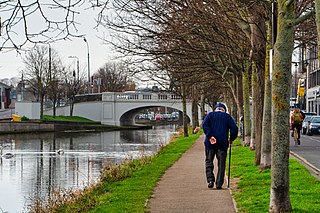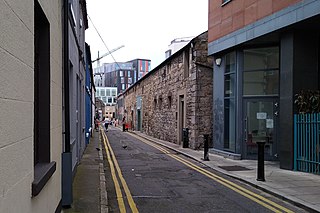
The River Liffey is a river in eastern Ireland that ultimately flows through the centre of Dublin to its mouth within Dublin Bay. Its major tributaries include the River Dodder, the River Poddle and the River Camac. The river supplies much of Dublin's water and supports a range of recreational activities.

The Grand Canal is the southernmost of a pair of canals that connect Dublin, in the east of Ireland, with the River Shannon in the west, via Tullamore and a number of other villages and towns, the two canals nearly encircling Dublin's inner city. Its sister canal on the Northside of Dublin is the Royal Canal. The last working cargo barge passed through the Grand Canal in 1960.

Harold's Cross is an affluent urban village and inner suburb on the south side of Dublin, Ireland in the postal district D6W. The River Poddle runs through it, though largely in an underground culvert, and it holds a major cemetery, Mount Jerome, and Our Lady's Hospice.

Templeogue is a southwestern suburb of Dublin in Ireland. It lies between the River Poddle and River Dodder, and is about halfway from Dublin's centre to the mountains to the south.

Ringsend is a southside inner suburb of Dublin, Ireland. It is located on the south bank of the River Liffey and east of the River Dodder, about two kilometres east of the city centre. It is the southern terminus of the East Link Toll Bridge. Areas included in Ringsend are the south side of the Dublin Docklands, and at the west end is the area of South Lotts and part of the Grand Canal Dock area. Neighbouring areas include Irishtown, Sandymount and the Beggars Bush part of Ballsbridge to the south, and the city centre to the west. A key feature of the area is the chimneys of Poolbeg power station.

The River Dodder is one of the three main rivers in Dublin, Ireland, the others being the Liffey, of which the Dodder is the largest tributary, and the Tolka.

The Liberties is an area in central Dublin, Ireland, located in the southwest of the inner city. Formed from various areas of special manorial jurisdiction, separate from the main city government, it is one of Dublin's most historic working class neighbourhoods. The area was traditionally associated with the River Poddle, market traders and local family-owned businesses, as well as the Guinness brewery, whiskey distilling, and, historically, the textiles industry and tenement housing.

The River Tolka, also once spelled Tolga, is one of Dublin's three main rivers, flowing from County Meath to Fingal within the old County Dublin, and through the north of Dublin city, Ireland. By flow of water, the Tolka is the second largest river in Dublin, following the Liffey, but runs more slowly than the Dodder.

The River Poddle is a river in Dublin, Ireland, a pool of which gave the city its English language name. Boosted by a channel made by the Abbey of St. Thomas à Becket, taking water from the far larger River Dodder, the Poddle was the main source of drinking water for the city for more than 500 years, from the 1240s. The Poddle, which flows wholly within the traditional County Dublin, is one of around a hundred members of the River Liffey system, and one of over 135 watercourses in the county; it has just one significant natural tributary, the Commons Water from Crumlin.

Dolphin's Barn is an inner city suburb of Dublin, Ireland, situated on the Southside of the city in the Dublin 8, and partially in the Dublin 12, postal district.

Rialto is an inner suburb of Dublin, situated on the city's southside. The area takes its name from the Harcourt Bridge, which was commonly known as the Rialto Bridge due to its resemblance to the shape of the bridge of that name in Venice.

The R112 road is a regional road in south Dublin, Ireland. It begins at the junction with the R148 road at Chapelizod and arcs southeastwards, then eastwards across the middle of south Dublin, ending at the Mount Merrion junction of the R138. The road is a single carriageway, with cycle lanes on some stretches. Improvements to the road have been made over the last 10 years, the most significant being at Dundrum Cross where the road was widened to make room for the new Luas bridge and Dundrum bypass.

The Coombe is a historic street in the south inner city of Dublin, Ireland. It was originally a hollow or valley where a tributary of the River Poddle, the Coombe Stream or Commons Water, ran. The name is sometimes used for the broader area around, in which the Poddle and its related watercourses featured strongly.

Fumbally Lane is a narrow and historic street in Dublin, Ireland, south of the city centre in The Liberties, 'In name and character perhaps the most evocative of all the Liberties' streets.' It connects Blackpitts to New Street and is close to St Patrick's Cathedral.

Blessington Street Basin is a former drinking water reservoir in northern central Dublin which operated from 1810 until the 1970s, serving the north city. It became the central feature of a public park in 1891, and this park was renewed and reopened in 1994.

Nicholas Queytrot (t) (c. 1475 – c. 1550), also called Nicholas Greytrot or Nicholas Coitrotte, was a wealthy merchant and citizen of Dublin city in the sixteenth century, who served one term as Mayor of Dublin in 1523-4.

Fatima is a stop on the Luas light-rail tram system in Dublin, Ireland. It opened in 2004 as a stop on the Red Line. The stop is at the southern side of St. James's Hospital, adjacent to James's Walk. Fatima is named for its proximity to Fatima Mansions, a public housing complex. It provides access to the suburbs of Dolphin's Barn, The Coombe, and The Liberties. The stop has two edge platforms, and is of the same design as many Luas stops. After departing the stop, northbound trams turn left and traverse the grounds of the hospital on their way to Connolly or The Point. Southbound trams continue along an abandoned canal alignment, travelling towards Tallaght or Saggart.

Crampton Court, also colloquially known as Love Lane since the mid-2010s, is a short lane or passageway located in Temple Bar in central Dublin, Ireland. A small open-air square exists at approximately the halfway point of the lane, measuring approximately 11.5 by 16.7 metres wide, from which narrow, semi-covered lanes lead to its northern and southern entrances.

The City Basin was a public reservoir and cistern constructed near St James' Street, Dublin around 1721 to supply the City of Dublin with water.

















